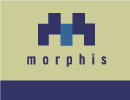

| Morphis |
| home |
| features |
| use patterns |
| downloads |
| documentation |
| javadoc |
| LGPL License |
| WAX |
| features |
| documentation |
| reference |
| examples |
Morphis WAX Features
Morphis WAX is a markup language, and a set of associated tools that enable fast and easy creation of wireless applications. WAX stands for Wireless Abstract XML, yet it includes far more than the language itself. Features of WAX include:
- WAX language: The WAX markup language is aimed at wireless application
development. It is based on constructs of both HTML and WML, and includes
features of both languages. WAX tags are designed to be at a higher level
of abstraction than prior standard wireless markup languages, and may translate
to different GUI metaphors when rendered on different devices. For example,
the
<wax:binarychoice>tag renders as two soft-key choices on most Phone.Com browsers, but will render as a drop-down box on a Palm Pilot. Both Morphis and WAX are extensible, so adding new tags to the language is easy, and the functionality of the tags may be quite complex.
- Translation Stylesheets: Usually the last WAX processing step is
to translate WAX language into a language best suited to the requesting device.
This language may be HTML, HDML, WML or any other language understood by the
device. WAX includes XSLT stylesheets to convert WAX into these browser-specific
languages. Stylesheets may target a generic set of devices (e.g. WML 1.1),
or target an individual device. Currently, Morphis includes stylesheets for
Nokia browsers, Phone.Com 3.0 and 4.0 browsers, generic WML browsers, HDML
browsers, HTML browsers (like AvantGo), cHTML browsers, NeoPoint devices.
This list is constantly growing as the Morphis and WAX development community
targets more and more devices.
- Device Registry: Morphis includes an XML database of devices, devices
recognition rules, and device attributes and features. Morphis uses the registry
to determine how best to deliver content, and may be extended by developers
to create device groupings and deliver content best suited to these device
groups. For example, if a bug is found in a family of devices, these devices
can be grouped and fixed via stylesheets, Morphis filters, or any other device-aware
application logic.
- Dynamic Image and Text Selection: WAX may be marked up with logical
image and text identifiers. The Morphis processor looks up the logical identifier
in the appropriate image or text registry, and processes rules to determine
which is the best physical item to deliver. This way content can be written
once, and variations of content such as different languages, may be placed
into separate "resource files". Images may even be named in a particular
fashion so they will automatically be delivered to an individual device, or
group of devices. This way you can have multiple images on disk, and have
the right one delivered to the right device.
- Application Foundation: Morphis WAX includes a WAXServlet as the
basis for building WAX applications. This is entirely optional as WAX may
be created in any application server as illustrated in the Morphis usage
patterns. However, using Morphis and WAX classes as the foundation to
your application automatically provides you with features like application
logging and database pooling.
- All the features of Morphis: Including a configurable cache of WAX data before and after translation, cached WAX translation stylesheets, extensibility to add new tags and processing filters, and its Open Source development license.
